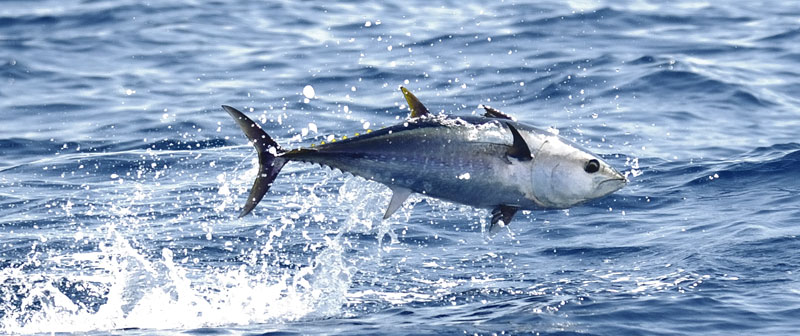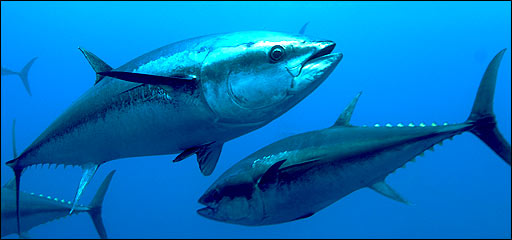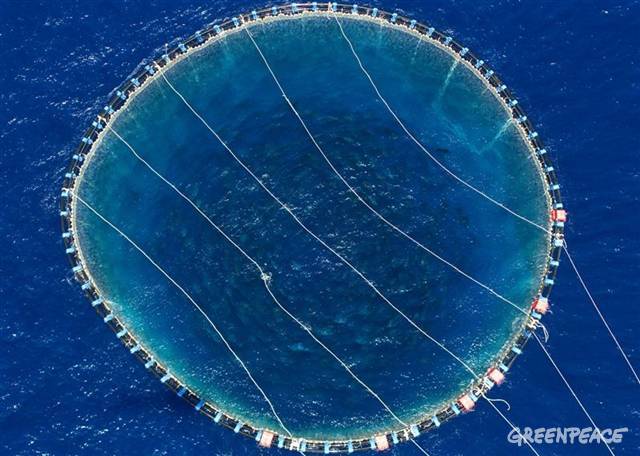If we were to name an iconic species of the Mediterranean sea and the straight of Gibralter, it would no doubt be the Atlantic bluefin tuna. Strangely, not many people know about this amazing animal, which is one of the biggest and one of the most commercially valuable fish in the world. Precisely for this, it has been heavily overfished for decades and the victim of widespread pirate fishing especially in its main spawning grounds across the Mediterranean.

Adults are typically 2 metres long but can reach over 4 metres, making the Atlantic tuna one of the largest bony fishes and the largest of all the tuna species. Adults average around 250kg, but the largest recorded specimen was a massive 679 kg - that’s heavier than a horse!
How fast can tuna swim? You`ll usually find them cruising around at 2.8-7.4km per hour, but can swim double that, nearly 15km per hour, for some time. But it’s when they’re chasing their prey or avoiding a hungry shark that they really let fly, accelerating faster than a Porsche and reaching speeds of 70, and maybe even 100 km per hour! No surprise then that the word tuna comes from a Greek word meaning “to rush”.
Atlantic bluefin tuna are not just fast sprinters they are also champion long-distance swimmers. These fish are found on both sides of the North Atlantic Ocean, from Brazil to Newfoundland in the west and West Africa to Norway in the east. Throughout their lives they roam this vast area searching for prey, returning each year to their spawning grounds in either the Gulf of Mexico or the Mediterranean Sea. These travels include trans-Atlantic crossings, which a bluefin can complete in less than 60 days. Up to 30% of the total population makes this voyage, with some individuals even making multiple crossings in a single year.
You probably learnt at school that fish are cold-blooded. That’s mostly true - but not for bluefin tuna. Their specialized circulation system allows them to retain up to 95% of the heat generated by their muscles. This means they can keep themselves much warmer than the surrounding water - essentially making them a warm-blooded fish!

Atlantic bluefin tuna must literally swim for their life. Their rigid head helps them to swim fast, but doesn’t allow them to pump water over their gills like some other fish. Instead, water is forced over their gills as they swim with their mouths open. But this means they need to keep swimming - like some sharks, if they stop they will die.
Tuna are fearsome predators from the moment they hatch. They hunt by sight, and have the sharpest vision of any bony fish. Adult Atlantic bluefin tuna eat schooling fish like herring, mackerel, flying fish, and anchovies, as well as squid, eels, and crustaceans and occasionally starfish and even kelp. They can dive down to around 1,000m to find food.
Atlantic bluefin tuna larvae have only a 1 in 40 million chance of reaching adulthood. But the lucky few are amongst the ocean’s top predators. They can expect to live for at least 15 years, and even as long as 30. They’re not quite at the top of the food chain though. Their fast speed allows them to escape most predators except for large sharks, toothed whales like killer whales and pilot whales… and humans.
 Atlantic bluefin tuna has long been valued in the Mediterranean, where it provided food for numerous civilizations and created wealth. This is in stark contrast to North America, where prior to the 1960s it could only be sold for pet food!
Atlantic bluefin tuna has long been valued in the Mediterranean, where it provided food for numerous civilizations and created wealth. This is in stark contrast to North America, where prior to the 1960s it could only be sold for pet food!
But in the 1960s, international markets for canned and fresh tuna arose following the development of longlines, purse seines, and freezing equipment that allowed frozen tuna to be shipped long distances. Soon, large numbers of commercial purse seiners were catching Atlantic bluefin tuna for canning.
By the 1970s, attention switched to giant bluefin tuna for the Japanese market, where the bluefin had become a highly sought-after delicacy for sushi and sashimi.
Longliners, harpooners, and purse seiners all targeted the giants, driven by the high prices paid in Japan - which consumes 40% of global bluefin landings and where a single bluefin has sold for over $ US 736,000! These fleets have used ever-more sophisticated means to find the tuna, including spotter planes and sonar equipment.
In the late 1990s came a new development in the bluefin tuna industry: tuna farms, which could be the final nail in the coffin for the endangered eastern population.
The farms are actually fattening pens for live-caught bluefin tuna, and supply a new market in Japan for cheaper bluefin tuna for sushi and sashimi. Suddenly, the prized bluefin was affordable for nearly all Japanese, not just the wealthy. Demand soared...and so did the fishing effort.

The practice of transferring live tuna at sea to tug boats for transportation to the farms makes it extremely difficult to keep track of how many tuna were transferred, and what size they were.
Japan, which imports most of the bluefin tuna captured in the Mediterranean, has strict rules prohibiting IUU fish from entering the country. However, China and other Southeast Asian countries are less strict. Their ports would likely accept illegally caught bluefin tuna from the Mediterranean.